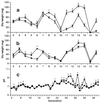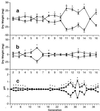Artificial ecosystem selection
- PMID: 10890915
- PMCID: PMC16830
- DOI: 10.1073/pnas.150237597
Artificial ecosystem selection
Abstract
Artificial selection has been practiced for centuries to shape the properties of individual organisms, providing Darwin with a powerful argument for his theory of natural selection. We show that the properties of whole ecosystems can also be shaped by artificial selection procedures. Ecosystems initiated in the laboratory vary phenotypically and a proportion of the variation is heritable, despite the fact that the ecosystems initially are composed of thousands of species and millions of individuals. Artificial ecosystem selection can be used for practical purposes, illustrates an important role for complex interactions in evolution, and challenges a widespread belief that selection is most effective at lower levels of the biological hierarchy.
Figures



Comment in
-
Heritability at the ecosystem level.Proc Natl Acad Sci U S A. 2000 Aug 15;97(17):9365-6. doi: 10.1073/pnas.97.17.9365. Proc Natl Acad Sci U S A. 2000. PMID: 10944208 Free PMC article. No abstract available.
References
-
- Sober E, Wilson D S. Unto Others: The Evolution of Altruism. Cambridge, MA: Harvard Univ. Press; 1998.
-
- Goodnight C J, Stevens L. Am Nat. 1997;150:S59–S79. - PubMed
-
- Williams G C. Adaptation and Natural Selection: A Critique of Some Current Evolutionary Thought. Princeton: Princeton Univ. Press; 1966.
Publication types
MeSH terms
LinkOut - more resources
Full Text Sources
Other Literature Sources

